BALANCING INNOVATION AND VULNERABILITY: WATER SECURITY IN AN AGE OF CYBER-WARFARE
Price
Free (open access)
Transaction
Volume
242
Pages
12
Page Range
71 - 82
Published
2020
Paper DOI
10.2495/WP200071
Copyright
WIT Press
Author(s)
KATRINA PETERSEN, PETER WIELTSCHNIG
Abstract
Through technological and organisational innovations, water services are increasingly finding new pathways to reduce water insecurity. For instance, the real-time detection of water pollution through the deployment of novel sensors can mitigate contamination problems before they become widespread. While these tools open up new forms of water security, they simultaneously create new forms of vulnerability as the connectivity and digitalisation of these infrastructures create remote pathways to control water system behaviours. The cyber-warfare capabilities of state and non-state actors are becoming increasingly sophisticated, and attacks have successfully infiltrated water systems with worrying potential. Indeed, in 2018, the US Department of Homeland Security and Federal Bureau of Investigations highlighted the threat of cyber-attacks from hostile countries on water systems, demonstrating the very real nature of these threats. This paper assesses the vulnerabilities arising from increasing interconnectivity and digitalisation in water infrastructures, paying particular attention to demographics at risk of insecurity. The paper starts by reviewing cyber-warfare practices relating to infrastructure, including their increasing frequency and sophistication. This is overlaid with a current demographic understanding of water insecurity and potential vulnerabilities to cyber-attack to identify what intersectionalities appear as new threats emerge. The paper then explores the necessary structure and value of ethical impact assessments in the design of innovative technology and practices in the water sector. In order to foster sensitivity to vulnerabilities and create avenues for incorporating scalable preventative and mitigating measures into design, a practical framework (in the form of a list of questions) is outlined. This paper finds that our understanding of water insecurity must adapt to the challenges posed by cyber-attacks. Sensitivity to the existence of these threats must be fostered and a practical framework developed to attune stakeholders to cyber-threats and assist those engaged with new technologies in the water sector.
Keywords
water security, cyber-attacks, cyber-security, intersectionality, ethics, environmental justice, vulnerability, internet of things, impact assessments, water pollution





